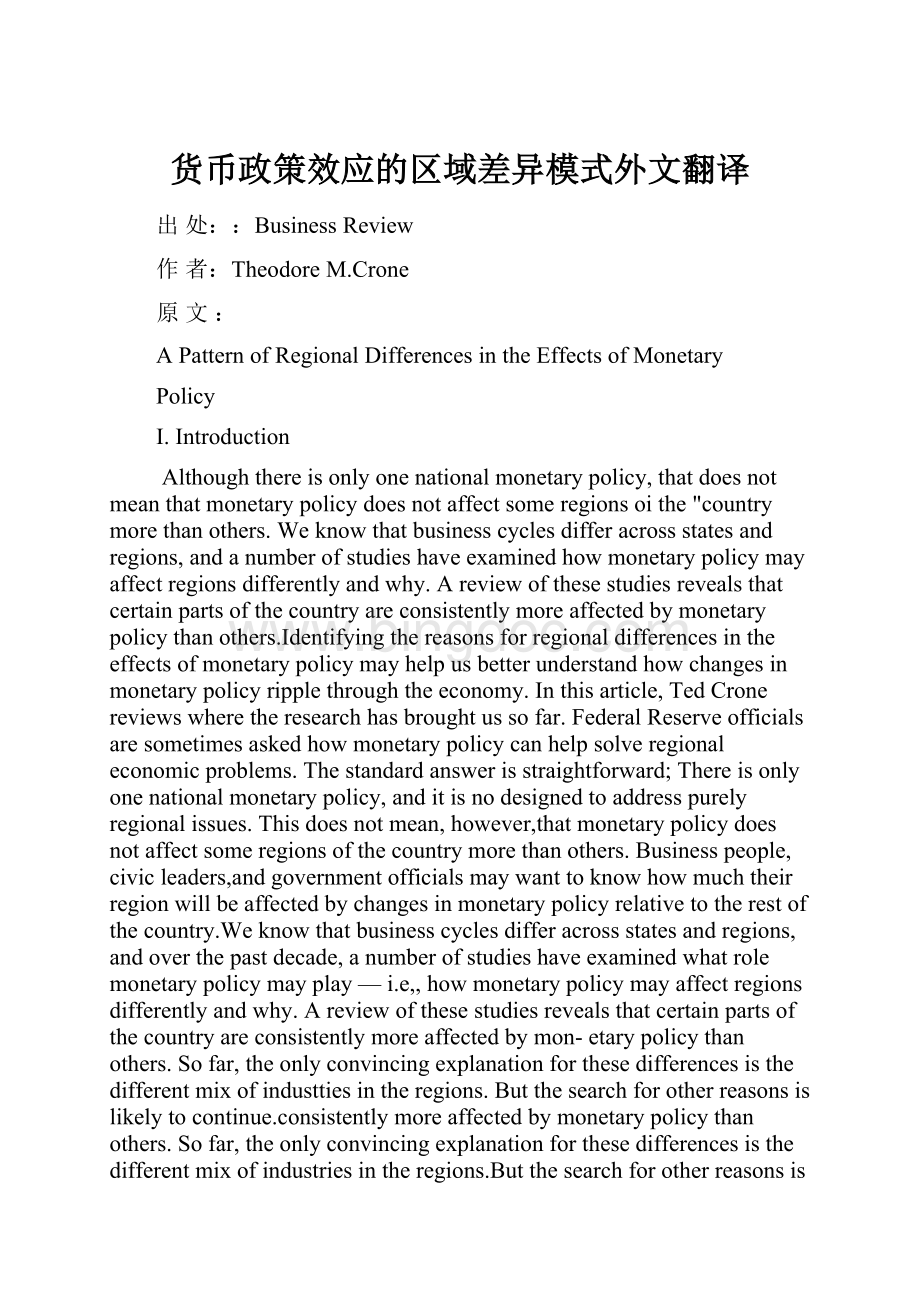货币政策效应的区域差异模式外文翻译.docx
《货币政策效应的区域差异模式外文翻译.docx》由会员分享,可在线阅读,更多相关《货币政策效应的区域差异模式外文翻译.docx(9页珍藏版)》请在冰点文库上搜索。

货币政策效应的区域差异模式外文翻译
出处:
:
BusinessReview
作者:
TheodoreM.Crone
原文:
APatternofRegionalDifferencesintheEffectsofMonetary
Policy
Ⅰ.Introduction
Althoughthereisonlyonenationalmonetarypolicy,thatdoesnotmeanthatmonetarypolicydoesnotaffectsomeregionsoithe"countrymorethanothers.Weknowthatbusinesscyclesdifferacrossstatesandregions,andanumberofstudieshaveexaminedhowmonetarypolicymayaffectregionsdifferentlyandwhy.Areviewofthesestudiesrevealsthatcertainpartsofthecountryareconsistentlymoreaffectedbymonetarypolicythanothers.Identifyingthereasonsforregionaldifferencesintheeffectsofmonetarypolicymayhelpusbetterunderstandhowchangesinmonetarypolicyripplethroughtheeconomy.Inthisarticle,TedCronereviewswheretheresearchhasbroughtussofar.FederalReserveofficialsaresometimesaskedhowmonetarypolicycanhelpsolveregionaleconomicproblems.Thestandardanswerisstraightforward;Thereisonlyonenationalmonetarypolicy,anditisnodesignedtoaddresspurelyregionalissues.Thisdoesnotmean,however,thatmonetarypolicydoesnotaffectsomeregionsofthecountrymorethanothers.Businesspeople,civicleaders,andgovernmentofficialsmaywanttoknowhowmuchtheirregionwillbeaffectedbychangesinmonetarypolicyrelativetotherestofthecountry.Weknowthatbusinesscyclesdifferacrossstatesandregions,andoverthepastdecade,anumberofstudieshaveexaminedwhatrolemonetarypolicymayplay—i.e,,howmonetarypolicymayaffectregionsdifferentlyandwhy.Areviewofthesestudiesrevealsthatcertainpartsofthecountryareconsistentlymoreaffectedbymon-etarypolicythanothers.Sofar,theonlyconvincingexplanationforthesedifferencesisthedifferentmixofindusttiesintheregions.Butthesearchforotherreasonsislikelytocontinue.consistentlymoreaffectedbymonetarypolicythanothers.Sofar,theonlyconvincingexplanationforthesedifferencesisthedifferentmixofindustriesintheregions.Butthesearchforotherreasonsislikelytocontinue.Identifyingthereasonsforregionaldifferencesintheeffectsofmonetarypolicymayhelpusbetterunderstandhowchangesinmonetarypolicyripplethroughtheeconomy.Thisarticlewillreviewwheretheresearchhasbroughtussofar..BUSINESSCYCLESDIEFERACROSSSTATESANDREGIONSⅡItiswidelyrecognisedthattherearedifferencesinbusinesscyclesacrossstates.Insomecases,itisthedepthsoftherecessions,andinothers,itisthetimingofrecessions.Differencesincyclesacrossmulti-stateregionsintheU.S.arelesspronouncedthandifferencesacrossindividualstates,buttheyarestilldiscernible.Tworecentstudieshaveusedanewlydevelopedsetofcoincidentindexesforthe50statestodefineandcomparestaterecessions.InanearlierBusinessReviewarticle,Iusedtheseindexestoexaminerecessionsatthestatelevelbasedonthetraditionaldefinitionofarecession—asignificantdeclineineconomicactivitythatlastsforseveralmonths.Usingthesamesetofindexes,inasecondstudy,economistsattheSt.LouisFedappliedastandardtechnique,knownasaMarkovswitchingmodel,toidentifydifferentphasesineachstate'seconomiccycle.Botharticlesfindthatthe50stateshaveexperienceddifferentbusinesscyclesintermsoftheirnumber,timing,andseverity.Otherstudieshaveexaminedtheissuefromadifferentperspective.Howcloselyarethecyclicalmovementsinincomeoremploymentcorrelatedacrossthestates?
Inastudypublishedin2001,ChristopheCrouxandhiscoauthorsproposedanewstatistic,calledacohesionindex,whichmeasurestheco-movementofregionaleconomiesoverthehusinesscycle.Theyapplythemeasuretopersonalincomeinthe50statesandfindthatwhilethecorrespondenceamongthestatesishigherthanthecorrespondenceamongtheEuropeancountries,itisnotperfect.Ina2004article,GeraldCarlinoandRobertDeFinacalculatethesamestatisticforemploymentineightmajorindustrygroupsacross38statesforwhichdataareavailahle.Avalueofonewouldindicateaperfectcorrelationofindustryemploymentbystateacrossbusinesscycles.Thus,foranindustrywithacohesionindexofone,quarterlyincreasesanddecreasesinemploymentduetothebusinesscyclewouldbeproportionalacrossallthestates.'Thecohesionmeasuresinthestudyrangefrom0.82formanufacturingto0.44formining.Thus,businesscyclesforthemajorindustriesdifferacrosstbestates.Theco-movementofincomeoremploymentamongmultistateregionsisstrongerthantheco-movementamongthestates,hutagain,itisnotperfect.'Ineffect,groupingstatestogethersmoothsoutsomeoftheindividualfeaturesofbusinesscycles,butitdoesnoteliminatethem.SincehusinesscyclesdifferacrossstatesandacrossregionsintbeU.S.,itisnaturaltoaskwhetherdifferentialeffectsofmonetarypolicyareafactor.Answeringthisquestionrequiresaconsistentframeworktomeasuretheeffectofmonetarypolicyontheeconomiesofstatesorregions..ESTIMATINGTHEREGIONALEFFECTSOFMONETARYPOLICYⅢInrecentyearseconomistshaveturnedtoeconometricmodelsknownasvectorautoregression(VAR)modelstomeasuretbeeffectsofchangesinmonetarypolicyonstatesandregions.AVARisasystemofequationsforestimatingthehistoricalrelationshipbetweenavariable,sucbaspersonalincomeinaregion,hypastvaluesofthatvariableandbycurrentandpastvaluesofothervariables,suchastheshort-terminterestratetargetedbytheFederalReserve(thefedfundsrate).Usingthistypeofmodel,wecanestimatetheeffectofanunanticipatedchangeinthefedfundsrateonincomeinastateorregion.Theseeffectsareknownasimpulseresponses.Ofcourse,theestimateswilldifferdependingonwhatvariablesareincludedintbemodelandwhatassumptionsaremade.Forexample,dochangesinmonetarypolicyaffectincomeinthecurrentperiodoronlyinlaterperiods?
Anddoshockstooneregion'seconomyspilloverdirectlytotheeconomiesofotherregions?
Therecentstudiesdiffersomewhatintbeirassumptions.Butallofthestudiesincludeintbeirmodelsthreekeyvariables:
personalincomeineachregion,thefedfundsrate,andsomemeasureotoilpricesorcommoditypricesingeneral.Someofthemodelsaddothervariablestothislist,suchastherateon10-yearTreasurybills.Ineachstudy,theregionaleffectsofmonetarypolicyaremeasuredbytheresponseovertimeoftheregion'spersonalIncometoanunanticipatedchangeinthetedfundsrate.Allofthemodelsassumethatunanticipatedchangesinthefedfundsrateaffectpersonalincomewithalagofatleastonequarter.Ideally,wewouldliketoestimatetheeffectsofmonetarypolicyoneachofthe50statesinasinglemodel.ButVARmodelsaresuitableonlyforalimitednumberofvariables,notthe50plusvariablestbatwouldberequiredtoincludeeachoftbestatesinthesamemodel.Therefore,thedifferentialeffectsofmonetarypolicyhavegenerallybeenestimatedbyregionratherthanbystate.'AndmostofthestudiesusetheeightregionsdefinedbytheBureauotEconomicAnalysis(BEA).'.TheEarliestModelⅣAbout10yearsagointheBusinessReview,GeraldCarlinoandRobertDeFinapublishedthetirstottberecentarticlesthatusedaVARmodeltoestimatetheregionaleffectsofmonetarypolicy.Theyassumethatmonetarypolicymakerscanreacttoashockorunanticipatedchangeinaregion'spersonalincomegrowthinthesamequarter.Personalincome,however,respondstochangesinmonetarypolicyonlyinsubsequentquartersbecausemonetarypolicyaffectstbeeconomyonlyaftersometimelag.Theauthorsalsoassumethatanychangetopersonalincomeinoneregioncanspillovertootherregionsinsubsequentperiods.Thtis,therecanbeatippleeffectacrossregions.Onthebasisoftheseassumptions,CarlinoandDeFinaestimatethecumulativeresponseofrealpersonalincomegrowthineachoftheeightBEAregionstoanunanticipatedincreaseinthefederalfundsrate.''Themaximumeffectineachregionofanunanticipatedchangeinthefederalfundsrateoccursaftertwototwo-and-a-halfyears.InthreeoftheeightBEAregions,thecumulativeeffectissignificantlydiffetentfromthenationalaverageafterafewquartersandremainssignificantlydifferentthrough20quarters.Figure1showsthecumulativeresponsesforthesethreeregions.IntheGreatLakesregion,theeffectofchangesinmonetarypolicyonpersonalincomeissignificantlygreaterthanthenationalaverage.IntheSouthwestandRockyMountainregions,theeffectissignificantlylessthanthenationalaverage.Thispatternreoccurstosomeextentinmostotherstudiesoftheregionaleffectsofmonetarypolicy.Inarecentstudyongroupingstatesintoregions,IfoundadditionalsupportforCarlinoandDeFina'sfindings.Inthe1950stheBEAgroupedcontiguousstatesintoeightregionsbasedonanumberofeconomicandsocialcharacteristicsatthattime.Buttherewasnoattempttoensurethatstatesinthesameregionhadsimilarbusinesscycles,animportantconsiderationforanalyzingregionalbusinesscycles.Igroupedcontiguousstatesintoregionsbasedonhowcloselytheireconomiesmovedtogetheroverthebusinesscycle(SeeAlternativeDefinitionsofRegionsintheU.S.)Itturnsoutthatoverthepastquartercentury,thebusinesscyclesinsomestatesweremorecloselyalignedwiththoseinstatesinneighboringBEAregionsthanthoseintheirownregion.Althoughtherealignmentofstatesintodifferentregionswasbasedonapurelystatisticalmeasureofthesimilarityinbusinesscycles,someoftherealignmentwasobvious.Forexample,mostobservers